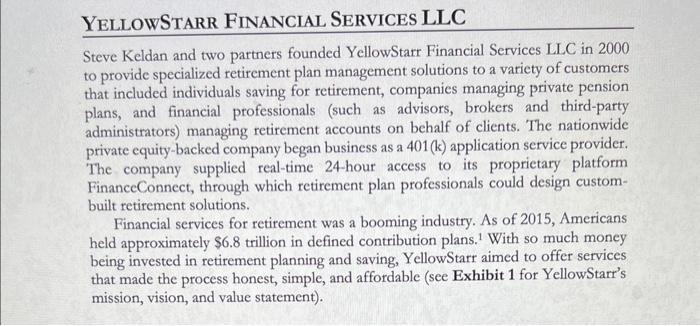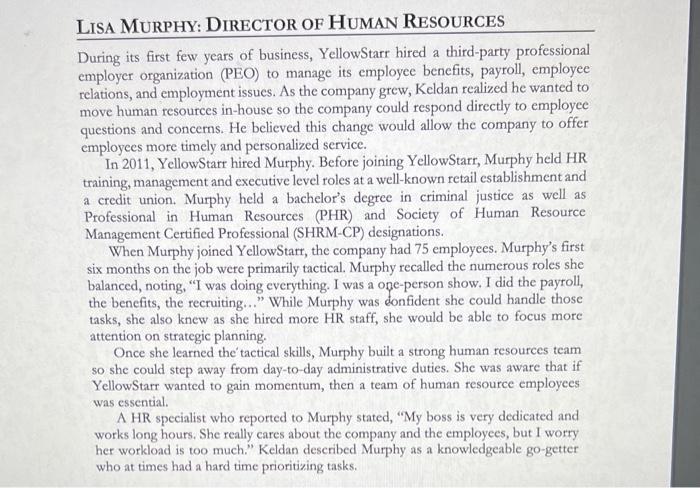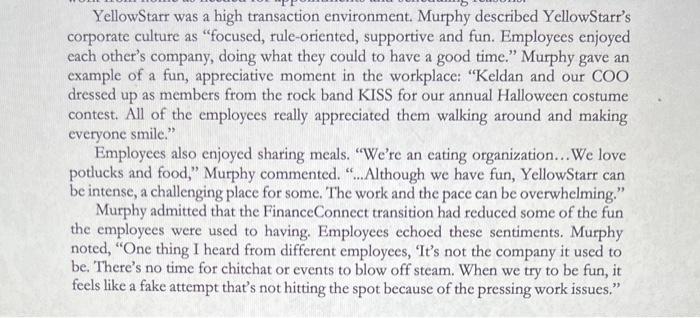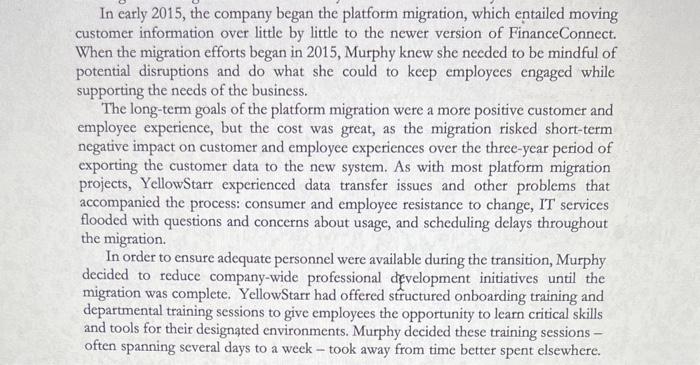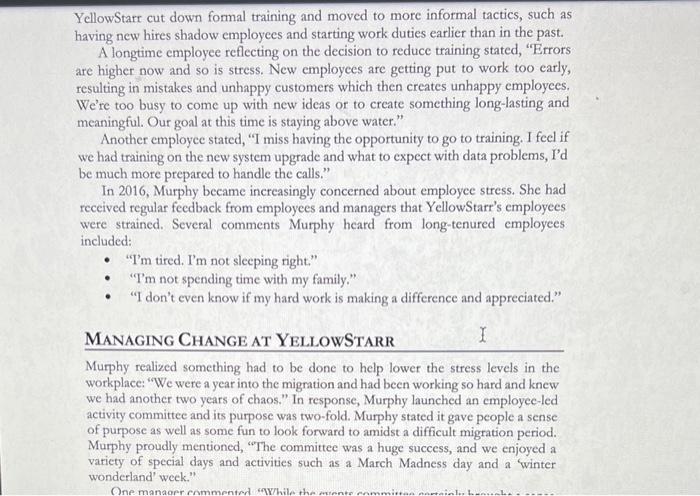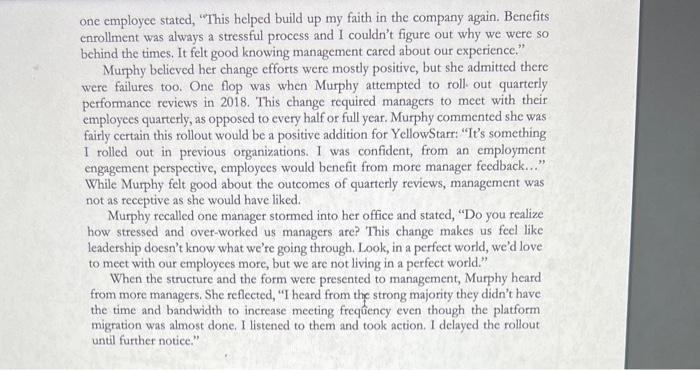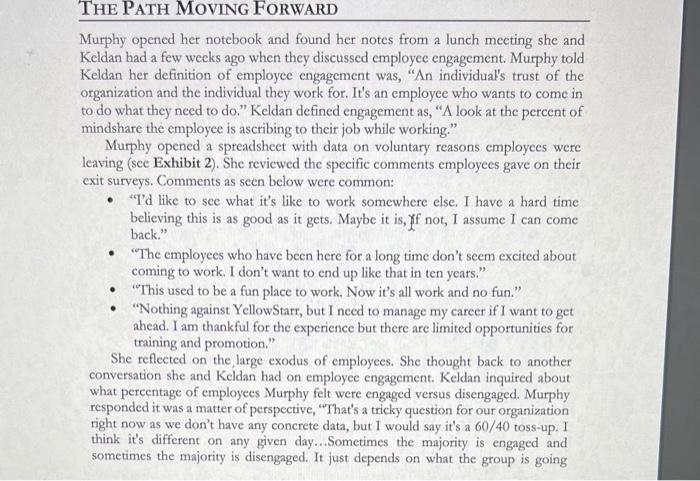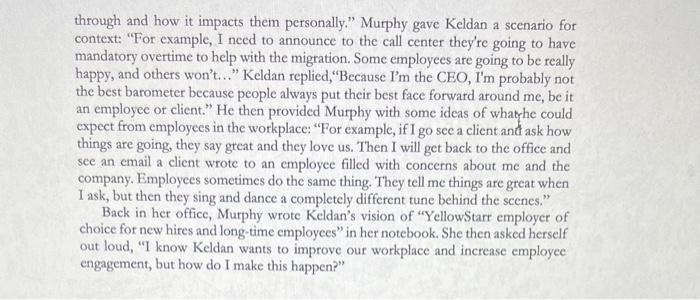Given the story below (I know its long but a very good read), suggest 3 ways for them to improve their workplace and employee engagement
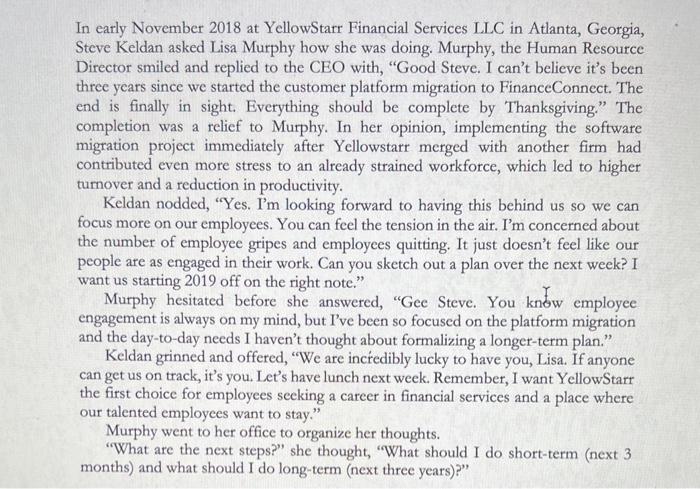
In early November 2018 at YellowStarr Financial Services LLC in Atlanta, Georgia, Steve Keldan asked Lisa Murphy how she was doing. Murphy, the Human Resource Director smiled and replied to the CEO with, "Good Steve. I can't believe it's been three years since we started the customer platform migration to FinanceConnect. The end is finally in sight. Everything should be complete by Thanksgiving." The completion was a relief to Murphy. In her opinion, implementing the software migration project immediately after Yellowstarr merged with another firm had contributed even more stress to an already strained workforce, which led to higher turnover and a reduction in productivity. Keldan nodded, "Yes. I'm looking forward to having this behind us so we can focus more on our employees. You can feel the tension in the air. I'm concerned about the number of employee gripes and employees quitting. It just doesn't feel like our people are as engaged in their work. Can you sketch out a plan over the next week? I want us starting 2019 off on the right note." Murphy hesitated before she answered, "Gee Steve. You know employee engagement is always on my mind, but Ive been so focused on the platform migration and the day-to-day needs I haven't thought about formalizing a longer-term plan." Keldan grinned and offered, "We are incredibly lucky to have you, Lisa. If anyone can get us on track, it's you. Let's have lunch next week. Remember, I want YellowStarr the first choice for employees seeking a career in financial services and a place where our talented employees want to stay." Murphy went to her office to organize her thoughts. "What are the next steps?" she thought, "What should I do short-term (next 3 months) and what should I do long-term (next three years)?" Steve Keldan and two partners founded YellowStarr Financial Services LLC in 2000 to provide specialized retirement plan management solutions to a variety of customers that included individuals saving for retirement, companies managing private pension plans, and financial professionals (such as advisors, brokers and third-party administrators) managing retirement accounts on behalf of clients. The nationwide private equity-backed company began business as a 401(k) application service provider. The company supplied real-time 24-hour access to its proprietary platform FinanceConnect, through which retirement plan professionals could design custombuilt retirement solutions. Financial services for retirement was a booming industry. As of 2015, Americans held approximately $6.8 trillion in defined contribution plans. 1 With so much money being invested in retirement planning and saving, YellowStarr aimed to offer services that made the process honest, simple, and affordable (see Exhibit 1 for YellowStarr's mission, vision, and value statement). During its first few years of business, YellowStarr hired a third-party professional employer organization (PEO) to manage its employee benefits, payroll, employee relations, and employment issues. As the company grew, Keldan realized he wanted to move human resources in-house so the company could respond directly to employee questions and concerns. He believed this change would allow the company to offer employees more timely and personalized service. In 2011, YellowStarr hired Murphy. Before joining YellowStarr, Murphy held HR training, management and executive level roles at a well-known retail establishment and a credit union. Murphy held a bachelor's degree in criminal justice as well as Professional in Human Resources (PHR) and Society of Human Resource Management Certified Professional (SHRM-CP) designations. When Murphy joined YellowStarr, the company had 75 employees. Murphy's first six months on the job were primarily tactical. Murphy recalled the numerous roles she balanced, noting, "I was doing everything. I was a one-person show. I did the payroll, the benefits, the recruiting..." While Murphy was eonfident she could handle those tasks, she also knew as she hired more HR staff, she would be able to focus more attention on strategic planning. Once she learned the tactical skills, Murphy built a strong human resources team so she could step away from day-to-day administrative duties. She was aware that if YellowStarr wanted to gain momentum, then a team of human resource employees was essential. A HR specialist who reported to Murphy stated, "My boss is very dedicated and works long hours. She really cares about the company and the employees, but I worry her workload is too much." Keldan described Murphy as a knowledgeable go-getter who at times had a hard time prioritizing tasks. YellowStarr was a high transaction environment. Murphy described YellowStarr's corporate culture as "focused, rule-oriented, supportive and fun. Employees enjoyed each other's company, doing what they could to have a good time." Murphy gave an example of a fun, appreciative moment in the workplace: "Keldan and our COO dressed up as members from the rock band KISS for our annual Halloween costume contest. All of the employees really appreciated them walking around and making everyone smile." Employees also enjoyed sharing meals. "We're an eating organization...We love potlucks and food," Murphy commented. "...Although we have fun, YellowStarr can be intense, a challenging place for some. The work and the pace can be overwhelming." Murphy admitted that the FinanceConnect transition had reduced some of the fun the employees were used to having. Employees echoed these sentiments. Murphy noted, "One thing I heard from different employees, 'It's not the company it used to be. There's no time for chitchat or events to blow off steam. When we try to be fun, it feels like a fake attempt that's not hitting the spot because of the pressing work issues." The average tenure of a YellowStarr employee was four years. A total of 54 employees left YellowStarr in 2018 (at the end of the software migration), equating to a turnover rate of 27%, which was approximately 9% higher than the industry average of 18.6%.2 In 2014 , the year of the merger, 43 employees, equating to 21.5%, left the company (See Exhibit 2). Of the turnover, consistently year after year, approximately 25% came from involuntary employee terminations, which were related mostly to attendance and/or performance concerns. According to a report from ADP Research Institute, the majority of turnover in the workforce was voluntary. Specifically, in the financial service industry, 64.9% of turnover was initiated by the employee. 3 YellowStarr's voluntary turnover in 2018 was 10.1% higher than average within the industry. Compensation and benefits were key reasons for voluntary departures at YellowStarr. Murphy reflected on engagement and the 2018 turnover rate and noted, "Up until this year, I think we've done a really good job with engagement, but this year, we lost dedicated and valuable people to other companies, which is unfortunate." Through employee exit interviews, Keldan and Murphy knew the stress of the migration led to an increase of employees departing because of work/life balance concerns. According to Keldan, The stress generated from the first months of data movement was the worst. With our first client data move in 2016, when we moved the clients' money, our client was supposed to test FinanceConnect, and I don't think they did. YellowStarr was then supposed to test FinanceConnect, and we didn't test it correctly. And when YellowStarr moved the clients' 80 plans over a weekend, they found certain things weren't working and we went immediately into crisis mode. And YellowStarr couldn't move it back, that wasn't an option. It creates stress on IT because they've got this pressure to remediate all these issues. Firm-wide, it created stress and crushed morale. To support the platform migration, employees oftentimes had to work longer shifts and many weekends. Taking vacation time also became a challenge. Regarding why employees were leaving for benefits-related concerns, Murphy did not have a clear understanding of the problem. Murphy did not have insight into what their competitors offered for benefits, so she wasn't certain if Y ellowStarr lacked in a specific area. Overall, Murphy believed the company offered competitive benefits to employees and believed employees didn't fully understand everything the company was contributing. Additionally, Murphy felt the rising cost of healthcare was taking a toll on employees. YellowStarr offered high deductible health plans, which meant the first few thousand dollars of an employee's health expense were out-of-pocket. Losing that significant chunk of income was stressful to employees. Murphy stated, "As a mid-size employer, it's hard to negotiate great healthcare options like large companies can. We do the best we can and offer health insurance plans that make sense for the employee and us." CHANGES AND CHALLENGES AT YELlowStarR In 2014, YellowStarr acquired another company. While the acquisition brought new customers, it also required employees to use two dyfferent systems: FinanceConnect and the other firm's software AB1. Although the two software systems served the same purpose, finding information was extremely different from one system to another. Employees had to use the AB1 software to access the newly merged customers' account information, which slowed down employees and led to some consumer dissatisfaction. New employees had to be trained on multiple systems, a cumbersome and time-consuming process. Although FinanceConnect had served YellowStarr well, by 2015, the company needed to undertake a major software upgrade to keep up with customer needs. FinanceConnect had become outdated in certain areas and was no longer working optimally with other platforms the company used. It was also time to get rid of AB1. YellowStarr also found it hard to find developers who would work on the software since it was outdated. YellowStarr was on a growth path and if FinanceConnect was reconfigured management felt it was a way to have more scalability. In early 2015 , the company began the platform migration, which entailed moving customer information over little by little to the newer version of FinanceConnect. When the migration efforts began in 2015, Murphy knew she needed to be mindful of potential disruptions and do what she could to keep employees engaged while supporting the needs of the business. The long-term goals of the platform migration were a more positive customer and employee experience, but the cost was great, as the migration risked short-term negative impact on customer and employee experiences over the three-year period of exporting the customer data to the new system. As with most platform migration projects, YellowStarr experienced data transfer issues and other problems that accompanied the process: consumer and employee resistance to change, IT services flooded with questions and concerns about usage, and scheduling delays throughout the migration. In order to ensure adequate personnel were available during the transition, Murphy decided to reduce company-wide professional development initiatives until the migration was complete. YellowStarr had offered structured onboarding training and departmental training sessions to give employees the opportunity to leam critical skills and tools for their designted environments. Murphy decided these training sessions often spanning several days to a week - took away from time better spent elsewhere. YellowStart cut down formal training and moved to more informal tactics, such as having new hires shadow employees and starting work duties earlier than in the past. A longtime employee reflecting on the decision to reduce training stated, "Errors are higher now and so is stress. New employees are getting put to work too early, resulting in mistakes and unhappy customers which then creates unhappy employees. We're too busy to come up with new ideas or to create something long-lasting and meaningful. Our goal at this time is staying above water." Another employec stated, "I miss having the opportunity to go to training. I feel if we had training on the new system upgrade and what to expect with data problems, I'd be much more prepared to handle the calls." In 2016, Murphy became increasingly concerned about employee stress. She had received regular feedback from employees and managers that YellowStarr's employees were strained. Several comments Murphy heard from long-tenured employees included: - "I'm tired. I'm not slecping right." - "Tm not spending time with my family," - "I don't even know if my hard work is making a difference and appreciated." Managing Change at YellowStarr Murphy realized something had to be done to help lower the stress levels in the workplace: "We were a year into the migration and had been working so hard and knew we had another two years of chaos." In response, Murphy launched an employec-led activity committee and its purpose was two-fold. Murphy stated it gave people a sense of purpose as well as some fun to look forward to amidst a difficult migration period. Murphy proudly mentioned, "The committee was a huge success, and we enjoyed a variety of special days and activities such as a March Madness day and a winter wonderland' week." One manager commented, "While the events committee certainly brought a sense of levity back to day-to-day operations, it also distracted employees from the evergrowing workload. Some employees would get aggravated that they didn't have enough time to participate in the fun and games or their peers were away from their desk when there were calls to take and paperwork to complete." Murphy continued her employee-focused efforts. In early 2017, she listened to an employee's suggestion and implemented what she believed was an important and successful change when she removed the requirement for formal dress at YellowStarr. Before this change, employees were required to wear business casual attire every day. Murphy proclaimed, "T've had people come up to me and say, ' Im more productive as a result of being able to wear what I want to work'... It also helps my morning stress when I don't have to worry about what I'm going to wear..." One long-tenured employee proclaimed, "This policy change is fantastic. Honestly, if this policy was revoked, Pd go looking for another job." In October 2018, Murphy rolled out automated open enrollment benefits software that enabled all employees to review and select their benefits from their smartphones or computers. Before the introduction of this open enrollment software, employees would have to revicw benefits information via paper every year and complete several sheets of paper to enroll. Once she finally enacted the software, Murphy observed, sense that many people expressed gratitude to HR and the company for stepping up to the plate for its employees." Reflecting on the change to online benefits enrollment, one employee stated, "This helped build up my faith in the company again. Benefits enrollment was always a stressful process and I couldn't figure out why we were so behind the times. It felt good knowing management cared about our experience." Murphy belicved her change efforts were mostly positive, but she admitted there were failures too. One flop was when Murphy attempted to roll. out quarterly performance reviews in 2018 . This change required managers to meet with their employees quarterly, as opposed to every half or full year. Murphy commented she was fairly certain this rollout would be a positive addition for YellowStarr: "It's something I rolled out in previous organizations. I was confident, from an employment engagement perspective, employees would benefit from more manager feedback..." While Murphy felt good about the outcomes of quarterly reviews, management was not as receptive as she would have liked. Murphy recalled one manager stormed into her office and stated, "Do you realize how stressed and over-worked us managers are? This change makes us feel like leadership doesn't know what we're going through, Look, in a perfect world, we'd love to meet with our employees more, but we are not living in a perfect world." When the structure and the form were presented to management, Murphy heard from more managers. She reflected, "I heard from the strong majority they didn't have the time and bandwidth to increase meeting frequiency even though the platform migration was almost done. I listened to them and took action. I delayed the rollout until further notice." Murphy opened her notebook and found her notes from a lunch meeting she and Keldan had a few weeks ago when they discussed employee engagement. Murphy told Keldan her definition of employee engagement was, "An individual's trust of the organization and the individual they work for. It's an employee who wants to come in to do what they need to do." Keldan defined engagement as, "A look at the percent of mindshare the employce is ascribing to their job while working." Murphy opened a spreadsheet with data on voluntary reasons employees were leaving (see Exhibit 2). She reviewed the specific comments employees gave on their exit surveys. Comments as seen below were common: - "T'd like to see what it's like to work somewhere else. I have a hard time believing this is as good as it gets. Maybe it is, \f not, I assume I can come back." - "The employees who have been here for a long time don't seem excited about coming to work. I don't want to end up like that in ten years." - "This used to be a fun place to work. Now it's all work and no fun." - "Nothing against YellowStarr, but I need to manage my carcer if I want to get ahead. I am thankful for the experience but there are limited opportunities for tmining and promotion." She reflected on the large exodus of employees. She thought back to another conversation she and Keldan had on employee engagement. Keldan inquired about what percentage of employees Murphy felt were engaged versus disengaged. Murphy responded it was a matter of perspective, "That's a tricky question for our organization right now as we don't have any concrete data, but I would say it's a 60/40 toss-up. I think it's different on any given day...Sometimes the majority is engaged and sometimes the majority is disengaged. It just depends on what the group is going through and how it impacts them personally." Murphy gave Keldan a scenario for context: "For example, I need to announce to the call center they're going to have mandatory overtime to help with the migration. Some employees are going to be really happy, and others won't..." Keldan replied, "Because I'm the CEO, I'm probably not the best barometer because people always put their best face forward around me, be it an employee or client." He then provided Murphy with some ideas of whatrhe could expect from employees in the workplace: "For example, if I go see a client and ask how things are going, they say great and they love us. Then I will get back to the office and see an email a client wrote to an employee filled with concerns about me and the company. Employees sometimes do the same thing. They tell me things are great when I ask, but then they sing and dance a completely different tune behind the scenes." Back in her office, Murphy wrote Keldan's vision of "YellowStarr employer of choice for new hires and long -time employees" in her notebook. She then asked herself out loud, "I know Keldan wants to improve our workplace and increase employee engagement, but how do I make this happen


